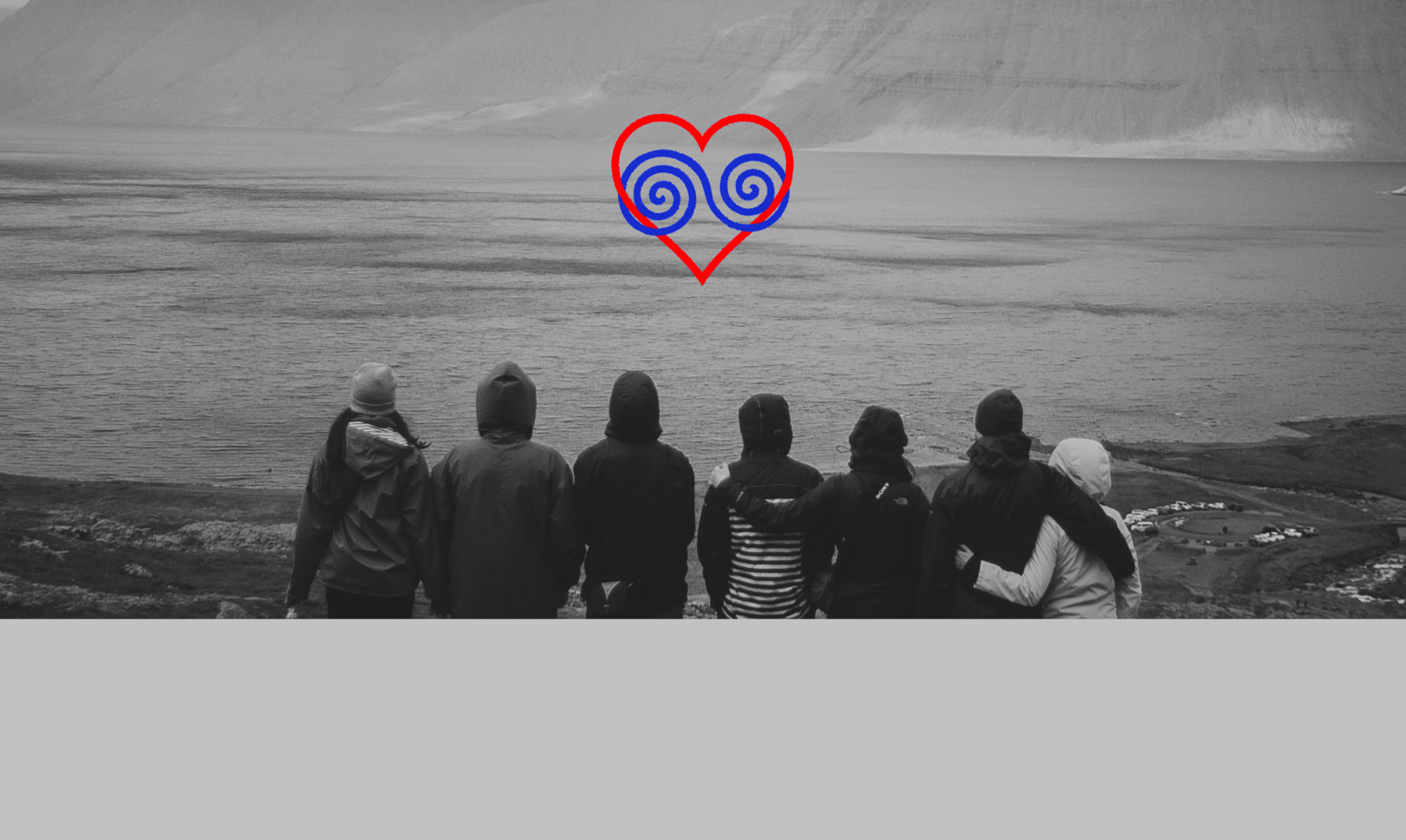Caretaker

The practice of ethical multiple relationships with a small number of participants, as I use the term to characterise my vision of Oligoamory, has a lot to do with community-building processes – which is something I point out in several of my Entries.
And in my example today, it is a truly amazing community that has been brought together.
I would like to briefly introduce them to you – starting with the adults:
There is, of course, the ever-active Cat, who is always bursting with ideas and does everything in her power to improve the group’s quality of life. A hard-working housekeeping hen called Marianne, who is often up for a little chat, is happy to help and advise her. They are also supported by a somewhat elderly dog, Captain Knaak, who once sailed at sea and acquired all kinds of practical skills there. The group also includes a light-shy arthropod known as “The Centipede” (an avid collector of burnt-out light bulbs) and the twin brothers Erbsenstein, two tinkerers and inventors who are so similar that not even their first names matter. The eldest member of the household is a stork-like animal that is affectionately known as “The Stumbling Bird”, since its long legs have become a bit tired by now and sometimes fail to perform.
This community also involves young people: There is a daydreaming female Llama teenager who spends a lot of her time napping and a talented wild boar kid, “Baby Hübner”, who vigorously pursues his ambition of a career as a composer and singer at the opera.
Of course, there are also smaller children: a lizard-like creature called “Zappergeck”, whose impulsiveness and audacity may possibly be an expression of a hyperactivity disorder. And – last but not least – a gentle bumblebee toddler, the “Puddingbrummsel”, who for her part still struggles a little with the world of language, but is nevertheless able to express herself.
Incidentally, this community was assembled by the two writers Desi and Simon Ruge in their book “Katze mit Hut” (→‘Cat with a Hat’, first: Beltz & Gelberg 1980¹) and the follow-up volume “Neues von der Katze mit Hut” (→‘News from the Cat with the Hat’, Beltz & Gelberg 1984).
The two books offer a wonderful, child-oriented overview of a community-building process, as it was set down seven years later by the “father of community-building”, Scott Peck, for an adult audience in his book “The Different Drum – Community Making and Peace” (Simon & Schuster, New York 1987).
Likewise in “Cat with a Hat”, the community members regularly have to pass through all the phases of shared life, which Scott Peck identified in his observations as “pseudo-community” (an initial, still rather superficial get-together), “chaos” (arguments, mutual lecturing and self-justification), “emptiness” (a phase of contemplation, reorganization and relaxation) and “true community” (genuine coming together and standing up for each other).
With such diverse characters involved, no one should be surprised!
I have already written a little about Scott Peck’s community-building process in Entry 8, so I won’t go into it too deeply here.
Today I would like to reflect on an aspect of cohabitation that appears in a minor marginal scene in “The Cat with the Hat”, but which seems to me to be of great importance (and I think it is no coincidence that Desi and Simon Ruge have included this detail in their work):
On the day the Cat discovers the new housemate “Centipede”, she, the dog Captain Knaak and Marianne the hen hear strange nocturnal noises from above the top floor. Together with the dog, the Cat climbs up to the attic (Marianne stays behind watching over the kitchen), where they are addressed by a hidden creature as soon as they switch on the light. The Cat asks the dog to switch off the light again, whereupon they both meet the arthropod “Centipede”, who is in the process of shelving his collection of burnt-out light bulbs – and who urges them never to turn on the light because it would cause pain to his sensitive eyes (which is why he would prefer the night for his activities anyway). A friendly dialogue ensues, at the end of which the Cat welcomes the Centipede into the domestic community and confirms his place in the attic – and assures him that he should not be disturbed by the rest of the group during daytime.
Cat and dog go back downstairs, but because Captain Knaak is also something like the janitor (the caretaker!) for the entire community, the Cat asks him on the stairs: “And take care that the shutters on the top floor stay closed during the day from now on.” Whereupon Captain Knaak replies committed and sincerely: “I don’t understand – but I care.” [Afterwards, the two return to Marianne and everyone goes to bed]
It was not until a couple of decades later, after I had encountered the “Cat with a Hat” in my own life as a literary figure and on the puppet stage, that I gradually realized that the simple words »I don’t understand – but I care.« were one of the most profound expressions of true affinity and loyalty I had ever encountered.
After all, meeting the centipede was almost too instantaneous for Captain Knaak, and his intellect doesn’t work as swiftly as the quick-witted Cat: A new, somewhat peculiar housemate, the dark attic, the odd collection of light bulbs…, a lot of information all at once.
Apart from a reasonably robust trust – both in the situation and with regard to the judgment of his companion Cat – Captain Knaak uses another important resource that goes beyond pure comprehension. “Comprehension” already contains the word “to comprehend” – and thus normally means that we have assessed a situation with our thinking, our reasoning and our intelligence. But when we do this, we also switch on our ability to judge and therefore always involve a certain degree of evaluation, which – depending on our previous experiences or our individual state of mind – it may not always be favourable.
By admitting “I don’t understand – but I care.”, Captain Knaak is expressing on a much more instinctive level a realization of the situation, his unconditional consideration, his respect – and above all his empathy (→ there is a living being with a need that I myself may not yet fully understand – but because I myself have needs where I am happy when they are respected, I can care even without exact intellectual insight into the situation).
Without much thought or additional contextual knowledge, Captain Knaak even manages the famed change of perspective in this short scene, according to the Indian proverb “Walk a mile in his*her moccasins.”
In a December Entry shortly before the Christian festival of Christmas, this is a touching message – without any spiritual monopoly, by the way – because the vast majority of other religions and faiths as well as numerous philosophical schools of thought in the world would also like to invite people everywhere to this form of kind-heartedness, tolerance and generosity – beyond evaluative reason and critical judgment.
Also the graduate psychologist and couple therapist Ulrich Wilken², who among other things has developed the relationship-counselling app “myndpaar”, lists as the five most important pillars of every stable and strong relationship: 1. having trust in the relationship (by which he means above all the basic trust in the consistency of the love shared within it), 2. identifying and overcoming old patterns (especially the self-sabotage caused by internalized beliefs such as “I am inadequate” or “I am unlovable”), 3. accepting your partner’s differentness (above all, maintaining respect and curiosity for your partner’s approach and view of the world), 4. communicating mindfully (golden rule: stay with yourself, speak in the first person, don’t hand out “diagnoses”) and 5. appreciating what is (keep consciously recognizing and honouring the many small treasure-moments of a relationship without demanding perfection).
Close human communities, whether at home or like in the animal commune of the Cat from Prune Alley, are always loving relationships in this best sense.
And these loving relationships are true as such when Mr. Wilken’s first two pillars are mutually dependent, if you like: I have “trust in the constancy of love within a relationship” when I feel safe and accepted there; when I feel – even unconsciously at best – that I am being seen, because I experience in many small ways that I am considered and respected.
If this experience is given, my place of love is also a place of trust – a place where I can rely on this trust without having to intellectually check every day whether I (still) belong there.
For multiple relationships – as in the case of the “relationship expansion” by the addition of the Centipede in the example above – this means that it enables me to engage more calmly with the dynamics of several partners (including new ones) because I have a resilient confidence in myself, my position and towards my other partners.
Oh, by the way – Captain Knaak also lovingly reminds us of the pillars 3 and 4:
Although it all happened very quickly for him, he is probably also curious about his new housemate – just like the Cat. As a dog, he can’t quite understand the Centipede’s passion for darkness and burnt-out light bulbs – but since he already lives with a cat and a hen in the same household, he has long since begun to accept that there are as many different ways of looking at the world as there are people – beg your pardon – housemates. Therefore, for him, this means that the Centipede with its individual characteristics will certainly contribute to further enrichment.
At this moment, Captain Knaak also manages to communicate a residual uncertainty while keeping things in a personal perspective: “I don’t understand.” In this way, he does not shift the responsibility to the Centipede (“Now that guy is creepy…”) or to the Cat (“It’s always you and your impulsive invitations…!”) – but because of his trust in the already existing overall relationship, he manages to remain optimistic, which allows him to contribute his own great asset of commitment and reliability (“I care.”).
Pillar 5 (appreciating what is) is very often a somewhat tricky part in all relationships that already have a certain lifespan (…we can see that the ” Cat with a Hat” is doing well by the fact that there are even two whole books about her house-sharing relationship…):
Spotting the “little relationship-treasures” is a bit like mixing Christmas and Easter together (or hiding the contents of an Advent calendar all over the home). We can encounter “appreciation” in many different forms, in the form of words or deeds, even items or services.
And it doesn’t matter whether it’s our favourite chocolate in the cupboard or the extra detour in the pouring rain: Above all, it is important that we ourselves sharpen our focus to welcome these little “treasures” for what they are – and not let them fall prey to a gray registry of obviousness and routine.
To prevent the latter, it is also important to pause, to reflect and actively ask yourself (and the others) how you have experienced the relationship recently (even a conversation like this can be a sign of appreciation in itself!) – and, for example, to consider jointly how the relationship could be strengthened for future challenges.
Anyone who encounters or experiences one of these little “treasures” in their everyday life – sometimes especially in an unlikely place or in an unforeseen situation – will usually immediately feel confirmed and strengthened in pillar 1 (trust in the flow of love).
Which is the best autoimmune cure for our relationships at any time of year…
My end of year wish today is therefore a very simple one. As we embark on such a journey with ourselves and with our loved ones, I hope that just like the Cat – and whatever the next year will bring – we will all exclaim together from the bottom of our hearts:
“But I like it here. Oh, I like it very much!”
¹ Currently: Simon and Desi Ruge – “Katze mit Hut”, Atrium Verlag 2019 and “Neues von der Katze mit Hut”, Beltz & Gelberg 1996 (no new edition available yet)
▪ Also note the very touching screen adaptation by the Augsburger Puppenkiste from 1982 (director: Sepp Strubel) on DVD or on YouTube. [content only available in German language]
² Dipl.-Psych. Ulrich Wilken is a psychological psychotherapist and founded the Institute for Systemic Studies in Hamburg over 30 years ago. Since then, he has worked as a lecturer and couples therapist. In 2021, he founded myndpaar – an AI-based psychotherapy app – with his daughter Leonie.
[The app can be used by anyone in “single person mode”, in “relationship mode” there is unfortunately only one version for a maximum of two participants – German language only].
Thanks to Moi Lolita on Pixabay for his AI-generated image that didn’t require a real cat to wear a hat!

